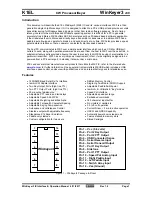
6-1
Chapter 6 Diversion Charge Control
The SunStar’s third mode of operation is diversion load battery charge control. As the
battery becomes fully charged, the SunStar will divert excess current from the battery to a
dedicated diversion load. This diversion load must be large enough to absorb all the excess
energy, but not too large to cause a controller overload condition.
6.1 Diversion Charge Control
In the diversion mode, the SunStar will use PWM charging regulation to divert excess
current to an external load. As the battery becomes fully charged, the FET switches are
closed for longer periods of time to direct more current to the diversion load.
As the battery charges, the diversion duty cycle will increase. When fully charged, all the
source energy will flow into the diversion load if there are no other loads. The generating
source is typically a wind or hydro generator. Some solar systems also use diversion to heat
water rather than open the solar array and lose the energy.
The most important factor for successful diversion charge control is the correct sizing of the
diversion load. If too large, the controller’s protections may open the FET switches and stop
diverting current from the battery. This condition can damage the battery.
If you are not confident and certain about the installation, a professional installation by your
dealer is recommended.
6.2 Diversion Current Ratings
The maximum diversion load current capability for the three SunStar versions is 30 amps
(SS-30C), 45 amps (SS-45C) and 60 amps (SS-60C). The diversion loads must be sized so
that the peak load current cannot exceed these maximum ratings.
6.3 Standard Diversion Battery Charging Programs
The SunStar provides 8 standard diversion charging algorithms (programs) that are selected
with the DIP Switches. An user define algorithm (Dip Switch 8 is ON) can be used for
custom setpoints using the two potentiometers, VR2 and VR1.
The table below summarizes the major parameters of the standard diversion battery
charging algorithms. Note that all the voltages are for 12V systems (24V = 2X, 48V = 4X).












































